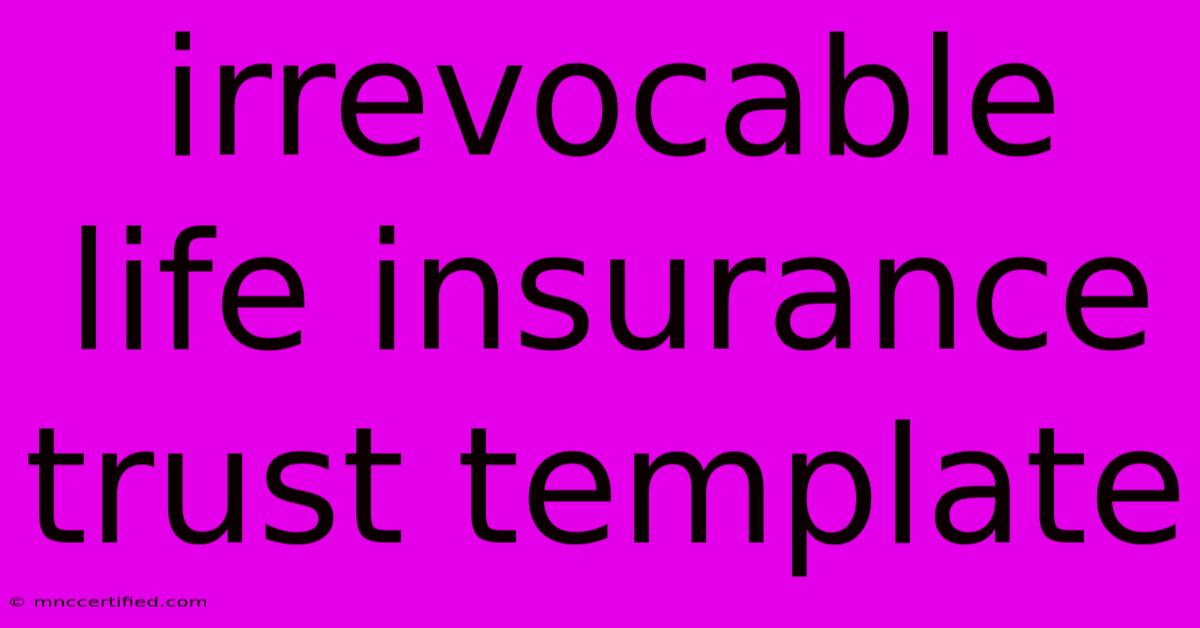Irrevocable Life Insurance Trust Template

Table of Contents
Irrevocable Life Insurance Trust Template: Unlocking Estate Planning Advantages
An irrevocable life insurance trust (ILIT) can be a powerful tool in your estate planning arsenal, offering numerous benefits such as tax savings, creditor protection, and estate liquidity. However, setting up an ILIT requires careful consideration and specific legal documents.
This guide will provide you with an understanding of the key elements of an ILIT template and highlight the significance of professional legal advice in structuring your trust.
What is an Irrevocable Life Insurance Trust (ILIT)?
An ILIT is a trust established to hold a life insurance policy and distribute the death benefit proceeds tax-free to your beneficiaries. The trust becomes the owner of the policy, and you (the grantor) relinquish control over it. This structure offers several advantages, including:
- Tax-Free Death Benefit: The death benefit is received tax-free by your beneficiaries as long as the ILIT is structured correctly.
- Estate Tax Reduction: Since the insurance policy is owned by the trust, its death benefit is excluded from your taxable estate.
- Asset Protection: Assets within an ILIT are typically protected from creditors and lawsuits.
- Flexibility: You can customize the terms of the trust to dictate how and when your beneficiaries receive the proceeds.
Key Components of an ILIT Template
A comprehensive ILIT template should include the following essential elements:
1. Trust Agreement:
- Trust Purpose: Clearly define the trust's purpose – to hold and distribute life insurance proceeds.
- Grantor and Trustee: Identify the grantor (you) who establishes the trust and the trustee who manages it.
- Beneficiaries: Name the individuals or entities who will receive the death benefit proceeds.
- Funding Provisions: Outline how the trust will be funded, including the life insurance policy.
- Distribution Provisions: Specify the terms and conditions for distributing the death benefit to beneficiaries.
- Management Provisions: Describe how the trustee will manage the trust's assets and investments.
- Dissolution Provisions: State how the trust will be dissolved and how the remaining assets will be distributed.
2. Life Insurance Policy:
- Ownership: The ILIT should clearly be named as the owner of the life insurance policy.
- Beneficiary: The ILIT should be designated as the beneficiary of the policy.
- Premium Payments: Detail how the premiums will be paid, either by the grantor or through a separate funding mechanism.
3. Other Essential Documents:
- Declaration of Trust: A formal document stating the intent to establish the trust.
- Power of Attorney: Granting the trustee the authority to manage the trust.
- Revocable Living Trust: Often used in conjunction with an ILIT to manage other assets and provide for the distribution of your estate.
Importance of Professional Legal Advice
While a template can provide a starting point, it is crucial to consult with an experienced estate planning attorney to tailor the ILIT to your specific circumstances. They can:
- Assess your individual needs: An attorney can help you determine if an ILIT is the right strategy for your situation.
- Draft personalized trust documents: Your attorney will ensure the trust is properly drafted and complies with all applicable state laws.
- Address potential tax implications: An experienced attorney can help you minimize tax liabilities associated with the ILIT.
- Choose the right trustee: An attorney can help you select a competent and trustworthy trustee to manage the trust.
Conclusion
An ILIT can be a valuable tool for minimizing estate taxes, protecting assets, and ensuring the distribution of your wealth according to your wishes. While readily available templates exist, it is vital to work with an experienced estate planning attorney to create a personalized and effective trust structure that aligns with your unique needs and goals.

Thank you for visiting our website wich cover about Irrevocable Life Insurance Trust Template. We hope the information provided has been useful to you. Feel free to contact us if you have any questions or need further assistance. See you next time and dont miss to bookmark.
Featured Posts
-
How To Get Insurance To Cover Liposuction
Nov 07, 2024
-
Hansi Flick On Pena And Gavi Plans
Nov 07, 2024
-
Stranger Things Season 5 Episode Titles Confirmed
Nov 07, 2024
-
Mens Basketball Plays Tough Game Against Indiana
Nov 07, 2024
-
Katy Perry Uk Concert Confirmed 6 Year Wait Ends
Nov 07, 2024